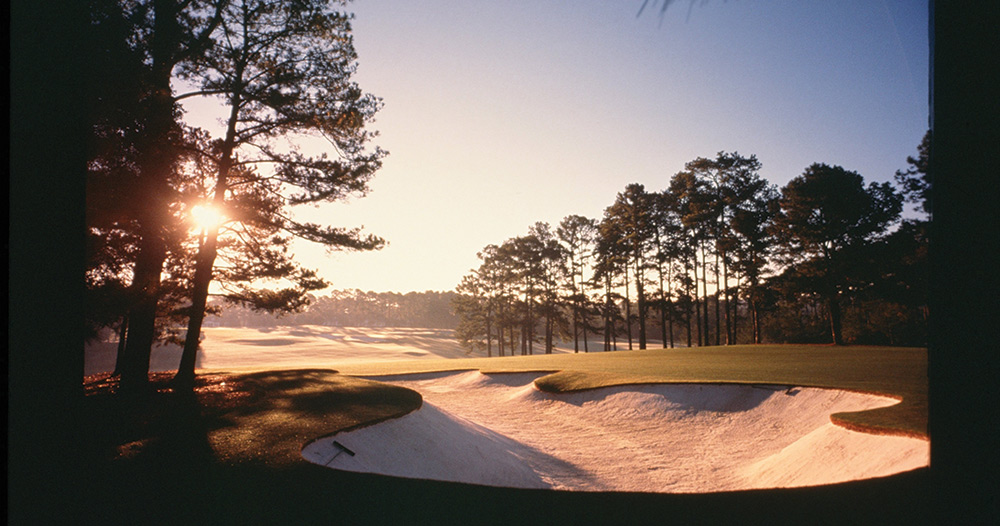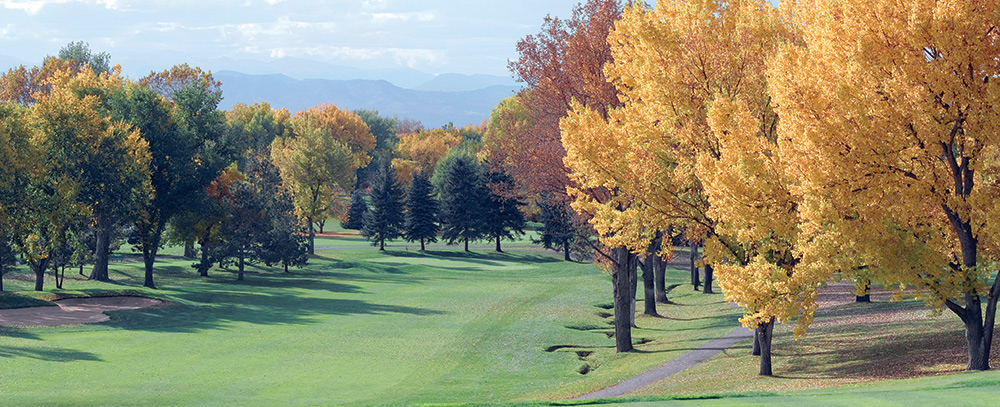
At Kingdom we have created a series of fantasy 18-hole golf courses consisting of outstanding holes that are all of the same number. Here we start at the beginning, with 18 first tees to savor.
For some, the first tee assumes an almost divine status. For others, it offers nothing but dread. Either way, every round of golf must have a beginning. Here we present a selection of opening holes that combine to create an 18-hole challenge that no golfer would ever be able to forget.

Old Course, St. Andrews, Scotland
Par-4, 370 yards
Like all good bedtime stories, we shall start at the very beginning. And golf’s very beginning is to be found at St. Andrews on the east coast of Scotland. Overlooked by the grey edifice that houses the Royal & Ancient Golf Club, the 1st tee on the Old Course should trigger the pulse of even the most relaxed individual. Quite simply, there’s no more fitting symbol of the game’s spirit—from its humble origins to its august pretentions. Few opening tees offer a wider target—despite out-of-bounds down the right, it’s almost impossible to go too far left. But don’t be deceived into thinking this hole is a pushover. Regardless of wind direction, the tricky part is the approach shot, clipped off a tight lie across the snaking Swilcan Burn to a shallow green.
standrews.com
Bay Hill Club & Lodge, Orlando, Florida
Par-4, 461 yards
After the relative simplicity of our ‘play away’ hole comes the man-sized challenge of the 1st at Arnold Palmer’s Bay Hill Club & Lodge, one of the more daunting openings on the PGA Tour. Mr. Palmer recently reshaped and toughened this difficult right-to-left dogleg, largely by spreading the traps at driving distance on the right edge of the fairway. Aiming left and trying to carry the cluster of mounds and trees on the elbow of the dogleg is for the longest hitters only, and even then the threat posed by the out-of-bounds hedge to the immediate left means only the most attacking, or tactically challenged, players will take it on. That said, Tour pros favor the left center of the fairway for the best angle to an undulating green protected on all four corners by bunkers.
bayhill.com
Royal Lytham & St. Annes, Lancashire, England
Par-3, 206 yards
The only modern major-championship venue starting with a short hole is this charming yet quirky links just south of the resort town of Blackpool. The last two [British] Opens at Lytham were won by Tom Lehman and David Duval, and it’s no surprise these former world No.1s are known as strong iron players. In this respect, the 1st provides a template for the test that lies in wait across the course. Needless to say, this is no gentle introduction—the tee shot is threaded through an avenue of trees to a green that’s slanted diagonally from front right to back left and protected by seven traps—four on the left and three on the right, beyond which is the railway line. No wonder Tony Jacklin, Open Champion in 1969, described the hole as a “terrible strain.”
royallytham.org

Old White Course, The Greenbrier, West Virginia
Par-4, 449 yards
Laid out in front of the clubhouse verandah by designer Charles Blair Macdonald, this revered opening hole was a particular favorite of the club’s former professional, Sam Snead. The amphitheaters behind the tee enable hundreds of observers—resort residents as well as club members—to watch, and gloat, as attempts are made to dispatch the ball down a straight but claustrophobically narrow, tree-lined fairway. Downhill and subtly curving, first to the left then back to the right, the turf tends not to deliver much run on the ball. Assuming you finish on the fairway, the approach, more often than not, must be played with a mid-to-long iron to a green framed by three bunkers—to the left, right and back.
greenbrier.com

Highlands Course, Atlanta Athletic Club, Georgia
Par-4, 454 yards
Atlanta Athletic Club, home to the great Bobby Jones, hosted the 1963 Ryder Cup over its East Lake layout when Arnold Palmer, the event’s last player-captain, led the U.S. to a 23-9 victory. Soon afterwards, the club relocated to Riverbend where its two 18-hole courses—Highlands and Riverside—were designed by Robert Trent Jones Sr. and remodeled by his son Rees. The Highlands has showcased major victories by Jerry Pate (1976, U.S. Open), Larry Nelson (1981, PGA) and David Toms (2001, PGA), and the PGA Championship returns there in August. The opening hole is a dogleg left, so a controlled draw is required to leave a short iron to the green. Tall trees stand guard left of the fairway while the right side is well bunkered. The key to the approach is to stay below the hole.
atlantaathleticclub.org
Ocean Course, National Golf Club, Victoria, Australia
Par-5, 539 yards
The National Golf Club’s three courses are a short drive south of Melbourne. Laid out in 2000 by Peter Thomson (the city’s favorite golfing son), Mike Woolveridge and Ross Perrett, the Ocean delivers a dazzling start. Played from the course’s highest point beside the clubhouse, this medium-length par-5 is only a small part of the breathtaking vista on view from the tee. A split fairway tempts big hitters to take the shorter, riskier line via a narrow plateau up the right while the longer, safer option is to aim down the low side to the left. The green is reachable in two with a following wind, otherwise the sensible lay-up is to around 100 yards. However, shots to the raised putting surface will roll back down the hill if they fail to carry the slope at the front.
nationalgolf.com.au/cms
La Moye, Jersey, Channel Islands
Par-3, 167 yards
Jersey, the biggest of the Channel Islands off the south coast of England, has two outstanding golf courses, one of which, La Moye in the southwest, starts with that rarity—a par-3. Designed by James Braid around 1930 and refined by another [British] Open champion, Henry Cotton, some three decades later, La Moye is mainly a links layout that is defined by large sand hills, pot bunkers, gorse bushes and punishing rough, not to mention a stiff and seemingly omnipresent wind. Right from the very first tee shot, precision, in terms of both direction and club selection, is essential. The 1st here may not be long, but its small, exposed plateau green is surprisingly elusive and surrounded at the front and sides by a string of four bunkers and over the back by impenetrable gorse bushes.
lamoyegolfclub.co.uk
Damai Golf & Country Club, Sarawak, Malaysia
Par-5, 564 yards
The course at Damai Golf & Country Club in the province of Sarawak on the island of Borneo was the first to be designed by Arnold Palmer in Malaysia. Carved into a spectacular setting consisting of sandy beaches, rocky outcrops and mangrove forests adjacent to the glistening South China Sea, it opened in 1996 and features two distinct 9-hole loops—the Mountain and the Ocean. The first half of the course—the Mountain Nine—tees off with a left-to-right dogleg par-5 that heads directly inland toward the foothills of Mount Santubong past a lengthy pond on the left and thick trees to the right. Ideally, the second shot should hold the left side of the fairway to set up a short-iron approach away from the trap that hugs the left side of the green.
damaigolf.com

Augusta National, Georgia
Par-4, 445 yards
This hole has stretched considerably beyond its initial 400 yards in recent times, though its elongation is understandable given its status as the springboard for the year’s opening major, the Masters. Named ‘Tea Olive,’ this partial dogleg right presents a classic ‘down and up’ fairway which players need to clear in order to leave themselves a relatively short approach to a slightly raised green. But for the likes of honorary starters Arnold Palmer, Jack Nicklaus and Gary Player, the hole has been transformed from a routine push across the valley into an almost insurmountable carry. For modern players, the main threats are the wide bunkers to the right of the fairway at driving distance and to the front left of the green, while hooks off the tee invariably fall foul of the encroaching screen of trees down the left.

Doonbeg, Co. Clare, Ireland
Par-5, 567 yards
Former world No.1 Greg Norman exercised his “least disturbance philosophy” when he mapped out Doonbeg on the west coast of Ireland. “When I first looked at this site, I thought I was the luckiest designer in the world,” said the Australian of the unspoiled setting for his ambitious layout. Spanning a mile and a half of crescent-shaped beach and centuries-old sand dunes, the course has views of the Atlantic from the green, fairway or tee on 16 of its 18 holes. Naturally with such an exposed piece of land, variations in wind speed and direction ensure different playing conditions every time. When playing the 1st, one of five par-5s, it’s easy to be distracted by the scenery and pay scant attention to the pot bunkers lurking alongside the fairway or the enormous dune guarding the green on three sides.
trumphotelcollection.com/ireland
DLF Golf & Country Club, New Delhi, India
Par-4, 365 yards
Many pundits believe the 18 holes designed by Arnold Palmer at DLF make up the finest course in India, a country destined surely to emulate China’s arrival as a modern golfing powerhouse. Opened in 1999 and set against the dramatic backdrop of the rugged Aravali mountain range, this beautiful parkland layout is adorned by five sparkling lakes, numerous streams and a bewildering variety of trees (no fewer than 140,000 were planted during landscaping). It is also the only course in India to offer floodlit golf and hosted its third European Tour event when the Avantha Masters took place in February earlier this year. This gentle starting hole is a clear birdie opportunity, but appearances can be deceptive. A pushed tee shot will easily find the meandering brook just right of the fairway and put an early dent on the scorecard.
dlfgolfresort.com
Brooklake Country Club, Florham Park, New Jersey
Par-3, 190 yards
Having spread our search for respectable opening par-3s both far and wide, we came across this delightful hole in front of the clubhouse at Brooklake, a prominent country club at Florham Park in Morris County, New Jersey. The course, designed by Herbert Strong in 1921 and revised two decades later, stretches beyond 7,000 yards from the back tees but is mainly flat and friendly. Its 1st hole, though, is not for the faint-hearted, and many a member and guest has suffered an attack of the jitters when confronted by the 100-yard watery grave that spreads from the tee to just short of the putting surface. With four sand traps strung out like pearls across the front of the green, the emphasis is on a cleanly-struck tee shot that fully flies the hole’s scorecard distance.
brooklakecc.com

Royal St. George’s, Sandwich, Kent, England
Par-4, 441 yards
The difficulty off the tee is to pick the ideal line from rugged, almost bleak terrain. As the opening hurdle at this year’s [British] Open Championship, this straight but narrow par-4 will swiftly deflate many challenges, especially if the wind whips in from the English Channel across the dunes lining the left side. Out-of-bounds some way to the right shouldn’t bother the world’s leading golfers, but thick rough just off the fairway certainly will. Also, the deep cross-bunker 80 yards short of the green will deter many players from starting with a driver. Those who hold the crumpled, undulating fairway face an approach across three further traps cut into the upslope to a large, curvaceous green that falls away from front to back. This course was the scene of Arnold Palmer’s 1975 victory in the British PGA Championship.
royalstgeorges.com

Four Seasons Golf Club, Peninsula Papagayo, Costa Rica
Par-5, 543 yards
The Four Seasons Golf Club opened to a Palmer design in 2004. Its seashore paspalum turf enables the fairways to be irrigated with salt water and stay green all year round. Laid out on a mountainside amidst a tropical rain forest populated by white-faced monkeys, the course tees off from its highest plateau overlooking Culebra Bay. The 1st is a sharp, left-to-right dogleg. Longer hitters can aim their tee shots over the line of three bunkers on the corner of the dogleg. Otherwise, a wide fairway up the left provides a safe, three-shot start to the round.
fourseasons.com/costarica
Blue Course, Congressional Country Club, Bethesda, Maryland
Par-4, 402 yards
This Blue Course will host the U.S. Open for the third time in June following a facelift that has taken it off the PGA Tour circuit these past two years. Opened by President Calvin Coolidge in 1924 as a bolt-hole for politicians based in Washington D.C. and prominent businessmen, the Blue was nominally designed by Devereux Emmet although the hand of Donald Ross in its creation is plain for all to see. More recently Robert Trent Jones (1964) and his son Rees (1997) adapted the layout to meet the USGA’s stringent standards in advance of the two previous U.S. Opens to be staged at Congressional. The opening hole, played against the prevailing wind, sets the scene with a gentle though tight right-to-left dogleg between a pair of fairway bunkers to a heart-shaped green virtually surrounded by traps.
ccclub.org

Cherry Hills Country Club, Denver, Colorado
Par-4, 397 yards
This downhill hole will forever be known as the launch-pad when Arnold Palmer turned a seven-shot deficit after 54 holes into a two-stroke victory in the 1960 U.S. Open. Angered at being told by sportswriter Bob Drum that he was too far back, Palmer drove the green to kick-start one of the greatest final-round charges in golfing history. The 1st has since been lengthened and is probably out of range for even the longest of hitters, which would have been the intention of designer William Flynn back in 1922. The whole course is in view from the tee, where the main concerns are a tree-lined creek running down the right and a fairway bunker on the left. An accurate pitch to a small, sloping green with a swale across its middle is required to achieve a birdie.
chcc.com
Southport & Ainsdale, Lancashire, England
Par-3, 204 yards
Another James Braid course and a near neighbor of Royal Birkdale where Arnold Palmer won the first of his two [British] Open crowns in 1961, Southport & Ainsdale is embedded amidst several magnificent sand hills and dunes. This links layout, where accuracy is as important as distance, twice played host to the Ryder Cup in the 1930s. Opening par-3s can be a recipe for slow play, but S&A members are convinced the slight initial delay this hole causes is justified by a generally smooth flow over the rest of the round. With a tee in front of the clubhouse and a small green protected by a semi-circle of nine bunkers, it can play anything from a mid-iron to a driver. The ball must be fired into the heart of the green as anything short will inevitably find sand.
sandagolfclub.co.uk
Oakmont Country Club, Pittsburgh, Pennsylvania
Par-4, 482 yards
To complete our fantasy 18, it is surely fitting we should conclude with one of the hardest tests in golf. This hole has posed a truly searching examination for the participants in the eight U.S. Opens to have been staged at Oakmont since 1927. The drive needs to be long and straight, threaded between a tight girdle of bunkers left and right in order to set up a blind mid-to-long-iron approach to a green that slopes away and is receptive to only the crispest of shots. Trees encroach all down the right of the fairway while to the left, particularly when the USGA come calling, the rough can assume the constituency of spinach. Two small traps guard the front left of a long, slick green where two putts is often the pinnacle of most players’ ambition.
oakmont-countryclub.org
Follow Us On


| Cookie | Duration | Description |
|---|---|---|
| cookielawinfo-checkbox-analytics | 11 months | This cookie is set by GDPR Cookie Consent plugin. The cookie is used to store the user consent for the cookies in the category "Analytics". |
| cookielawinfo-checkbox-functional | 11 months | The cookie is set by GDPR cookie consent to record the user consent for the cookies in the category "Functional". |
| cookielawinfo-checkbox-necessary | 11 months | This cookie is set by GDPR Cookie Consent plugin. The cookies is used to store the user consent for the cookies in the category "Necessary". |
| cookielawinfo-checkbox-others | 11 months | This cookie is set by GDPR Cookie Consent plugin. The cookie is used to store the user consent for the cookies in the category "Other. |
| cookielawinfo-checkbox-performance | 11 months | This cookie is set by GDPR Cookie Consent plugin. The cookie is used to store the user consent for the cookies in the category "Performance". |
| viewed_cookie_policy | 11 months | The cookie is set by the GDPR Cookie Consent plugin and is used to store whether or not user has consented to the use of cookies. It does not store any personal data. |